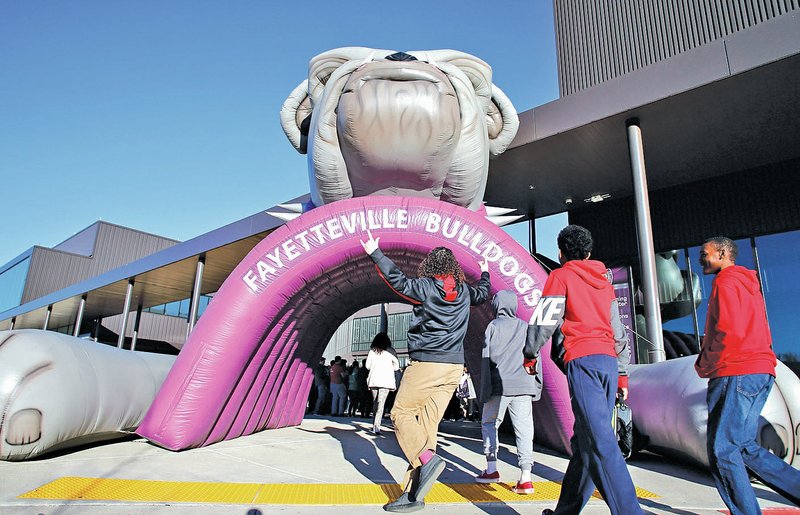FAYETTEVILLE -- Eighth-graders from Ramay and Woodland junior high schools exited buses in front of Fayetteville High School on Tuesday morning and found an inflated purple and gray Bulldog-shaped tunnel awaiting their arrival.
The school's marching band performed as the students walked from the tunnel through a path flanked by cheerleaders and the school color guard waving pom-poms and flags. Some eighth-graders seemed uncertain about how to react, while the big greeting brought big smiles and laughs from others.
They will make up the first class of freshmen to attend the high school after a $96 million transformation of the campus.
"I felt excited and free," said Ramay eighth-grader Damara Hale, 13. "It's a big step, but I feel ready."
Fayetteville High School administrators and teachers are preparing for two incoming classes of students to the campus in August -- the eighth-graders who will become freshmen and freshmen who will become sophomores next school year.
The eighth-graders spent Tuesday on the campus, while freshmen will spend Thursday there.
The first phase of construction, which totaled $45 million, began in the summer of 2010 and finished in August 2012. Construction of the second phase, a $51 million project, began in the summer of 2012 and will wrap up this summer.
Principal Steve Jacoby knows that moving from junior high schools of about 130,000 square feet to a campus of more than 500,000 square feet will be overwhelming.
Jacoby hoped giving the incoming classes a day on the campus would make them feel welcome and help them know the adults will work as a team to prepare for them for college and careers.
"You're going to have more personal freedom than you've ever had before," Jacoby told students Tuesday morning inside the Performing Arts Center. "With that freedom comes responsibility."
He told students to be wise about their choices and to develop a drive and passion to motivate themselves.
"We don't do easy," he said. "You can't take days off."
Eighth-grader Martha Arambel, 14, has enjoyed Ramay, but thinks moving freshmen to the high school will be a good change for the district. She was concerned about being judged as a "little ninth-grader" before spending a day at the high school, she said.
The greeting Tuesday morning made her feel enthusiastic about the move, she said.
During the morning session, Deanna Easton, dean of students and director of the high school's small learning communities, explained freshmen will be divided into four groups representing school colors -- a Purple A group, a Purple B group, a White A group and a White B group. Students in each group will have the same teachers for English, math, science and social studies but will mix with the rest of the student body for electives.
Students across the country make the transition from middle and junior high schools to high schools each year. When freshmen are the youngest class on the high school campus, they haven't yet learned to advocate for their needs, said Lauri Johnson, director of school leader development for the Southern Regional Education Board based in Atlanta.
Freshmen can feel anonymous when they make the transition, she said. Dividing students into small learning communities as Fayetteville can help students connect with the adults on campus.
Students also make a more successful transition when teachers know in advance what subjects will cause struggles for their students and make plans to provide extra support, Johnson said.
"Ninth grade, that's when students are finding their way," Johnson said. "Teachers have to get to know the students so they feel comfortable stepping out."
A Woodland eighth-grader, Elijah Garcia, 14, said he will enjoy seeing some of his older friends on the high school campus next school year, but he also fears getting lost.
"I'm kind of nervous," he said. "It's really big."
Getting students ready for high school begins with students selecting courses, said Lesli Zeagler, a high school counselor who led a question-and-answer session with the incoming freshmen Tuesday. Advisory classes help students navigate life at a large high school by providing a small "family" unit of a teacher and 12 to 15 students who are together throughout their high school education, she said.
"Once that initial shock wears off and they're where they're supposed to be, they'll be just fine," Zeagler said.
NW News on 01/28/2015
